Analysis of the Correctness of Mapping the Passage of a Semi-Trailer through a Road Obstacle on a Road Simulator
Abstract
1. Introduction
2. Tests
2.1. Experimental Studies
2.1.1. Measuring Techniques
- 1 MEMS capacitive accelerometer (ASC model 5521-050) with measurement in three axes (3 channels), a frequency response range from 0 [Hz] to 4000 [kHz] (±3 dB), a measuring range of 30 g and a sensitivity of 90 mV/g;
- 9 MEMS capacitive accelerometers (ASC model 4421MF), with a frequency response range from 0 Hz to 7 kHz (±3 dB), a measuring range of 30 g and a sensitivity of 90 mV/g;
- 6 displacement sensors (Waycon type SX50-625-1R-KA02-HG), with a measuring range of 625 mm, linearity up to ±0.02% of full scale and a resolution of 10 [imp/mm];
- 2 half-bridge strain gauges 120 Ω, one active and one passive (KYOWA model KFGS-10-120-C1-11), a gauge factor of 2.13 ± 1.0%, a bridge excitation of 2.5 V and a bridge factor of 2;
- 1 pressure sensor (HBM type P8AP/20), with a measuring range of 0–20 bar, a rated sensitivity of 2 ± 2% mV/V and a natural frequency of 16 kHz.
2.1.2. Distribution of Sensors on the Vehicle
2.1.3. Description of the Obstacle
2.2. Determination of the Run Data on the Road Simulator for the Tested Cases
2.3. Theoretical Model
- -
- Z2 vertical displacement of the vehicle as M;
- -
- Z1 vertical displacement of m, in the middle of the vehicle’s wheel.
3. Results
3.1. Results from the MTS 320 Test Rig
3.2. Results for the Numerical Model in Simulink
- -
- The first was the theoretical road shape signal for which the displacement signal was marked in black;
- -
- The second was the displacement signal marked in orange, generated for the input signal under the wheel from the MTS test rig.
4. Discussion
5. Conclusions
Author Contributions
Funding
Institutional Review Board Statement
Informed Consent Statement
Data Availability Statement
Conflicts of Interest
References
- Eurostat Freight Transport Statistics—Modal Split of Freight Transport; EU: Luxembourg, 2023.
- Fu, H.; Gao, J. Vehicle durability test based on user survey. Comput. Model. New Technol. 2014, 18, 479–483. [Google Scholar]
- Klyatis Lev, M. Accelerated Reliability and Durability Testing Technology; Wiley Series in Systems Engineering and Management; John Wiley & Sons: Hoboken, NJ, USA, 2012. [Google Scholar]
- Kosobudzki, M.; Stańko, M. Problems in assessing the durability of the selected vehicle component based on the accelerated proving ground test. Maint. Reliab. 2019, 21, 592–598. [Google Scholar] [CrossRef]
- Haiqiang, L.; Bo, Z.; Jintao, S.; Qinwen, D. Failure analysis of engine mounting bracket of a passenger car. Eng. Fail. Anal. 2022, 136, 106190. [Google Scholar] [CrossRef]
- Fricke, D.; Frost, M. Development of a Full-Vehicle Hybrid-Simulation Test using Hybrid System Response Convergence (HSRC). SAE Int. J. Passeng. Cars—Mech. Syst. 2012, 5, 921–936. [Google Scholar] [CrossRef]
- Yang, J.; Jacobs, G.; Kramer, A.; Drichel, P.; Liu, C. Investigation of the tire in-plane vibration property using an improved ring model. J. Sound Vib. 2020, 478, 115350. [Google Scholar] [CrossRef]
- Weng, H.; Huang, P.; Huang, W. Tire Mechanical Properties Based on Underwater Obstacle Impact. J. Coast. Res. 2020, 104, 988–992. [Google Scholar] [CrossRef]
- Hicks, D.; Mongiardini, M.; Grzebieta, R.; Rechnitzer, G.; Simmons, K. Modelling a quad-bike rollover mechanism when traversing an asymmetric bump. Int. J. Crashworth. 2019, 24, 543–554. [Google Scholar] [CrossRef]
- Martini, A.; Bonelli, G.P.; Rivola, A. Virtual Testing of Counterbalance Forklift Trucks: Implementation and Experimental Validation of a Numerical Multibody Model. Machines 2020, 8, 26. [Google Scholar] [CrossRef]
- Naets, F.; Geysen, J.; Desmet, W. An Approach for Combined Vertical Vehicle Model and Road Profile Identification from Heterogeneous Fleet Data. In Proceedings of the IEEE International Conference on Connected Vehicles and Expo, Graz, Austria, 4–8 November 2019; pp. 1–5. [Google Scholar] [CrossRef]
- Dargužis, A.; Sapragonas, J.; Pilkauskas, K. Dynamic processes of a vehicle moving over step-shaped obstacles. J. Vibroengineering 2011, 1392–8716. [Google Scholar]
- Basaran, S.; Basaran, M. Vibration Control of Truck Cabins With the Adaptive Vectorial Backstepping Design of Electromagnetic Active Suspension System. IEEE Access 2020, 8, 173056–173067. [Google Scholar] [CrossRef]
- Azrulhisham, E.; Asri, Y.M.; Dzuraidah, A.W.; Nik Abdullah, N.M.; Che Hassan, C.H.; Shahrom, A. Application of Road Simulator Service Loads in Automotive Component Durability Assessment. Open Ind. Manuf. Eng. J. 2011, 4, 1–7. [Google Scholar] [CrossRef][Green Version]
- Krishnasamy, P.; Jayaraj, J.; John, D. Experimental Investigation on Road Vehicle Active Suspension. Stroj. Vestn.—J. Mech. Eng. 2013, 59, 620–625. [Google Scholar] [CrossRef]
- Czarnuch, A.; Stembalski, M.; Szydłowski, T.; Batory, D. Method of reconstructing dynamic load characteristics for durability test of heavy semitrailer under different road conditions. Maint. Reliab. 2021, 23, 548–558. [Google Scholar] [CrossRef]
- Stembalski, M.; Czarnuch, A.; Batory, D. Collection of reference data for durability tests using a road simulator. In Proceedings of the International Business Information Management Association, Seville, Spain, 1–2 April 2020; pp. 11352–11365. [Google Scholar]
- Czarnuch, A.; Stembalski, M.; Szydłowski, T.; Batory, D. Methodology of the Durability Test od Semi—Trailers on the MTS 320 Road Simulator. In Proceedings of the TRANSBALTICA XIII: Transportation Science and Technology, Vilnius, Lithuania, 15–16 September 2022; pp. 236–246. [Google Scholar] [CrossRef]
- Jamali, M.S.; Ismail, K.S.; Taha, Z.; Aiman, M.F. Development of Matlab Simulink model for dynamics analysis of passive suspension system for lightweight vehicle. J. Phys. 2017, 908, 012066. [Google Scholar] [CrossRef]
- Czarnuch, A.; Lisowski, E. Studies of truck semitrailer stability during loading and unloading. Tech. Trans. Mech. 2013, 21, 21–28. [Google Scholar]
- Chen, Y.; Jie He, J.; King, M.; Chen, W.; Wang, C.; Zhang, W. Model Development and Dynamic Load-Sharing Analysis of Longitudinal-Connected Air Suspensions. Stroj. Vestn.—J. Mech. Eng. 2013, 59, 14–24. [Google Scholar] [CrossRef]
- Moheyeldein, M.; Abd-El-Tawwab Ali, M.; Abd El-gwwad, K.A.; Salem, M. An analytical study of the performance indices of air spring suspensions over the passive suspension. J. Basic Appl. Sci. 2018, 7, 525–534. [Google Scholar] [CrossRef]
- Design Manual; SAF Holland Group: Bessenbach, Germany, 2010.
- TBR Data Book; v17.1; Bridgestone: Tokyo, Japan, 2017.
- Ashtekar, J.; Thakur, A. Simulink model of suspension system and it’s validation on suspension test rig. Int. J. Mech. Eng. Robot. Res. 2014, 3, 2278-0149. [Google Scholar]
- Barethiye, V.; Pohit, G.; Mitra, A. A combined non-linear and hysteresis model of shock absorber for quarter car simulation on the basis of experimental data. Eng. Sci. Technol. Int. J. 2017, 20, 1610–1622. [Google Scholar] [CrossRef]
- Pazooki, A.; Rakheja, S.; Dongpu Cao, D. Modeling and validation of off-road vehicle ride dynamics. Mech. Syst. Signal Process. 2012, 28, 679–695. [Google Scholar] [CrossRef]


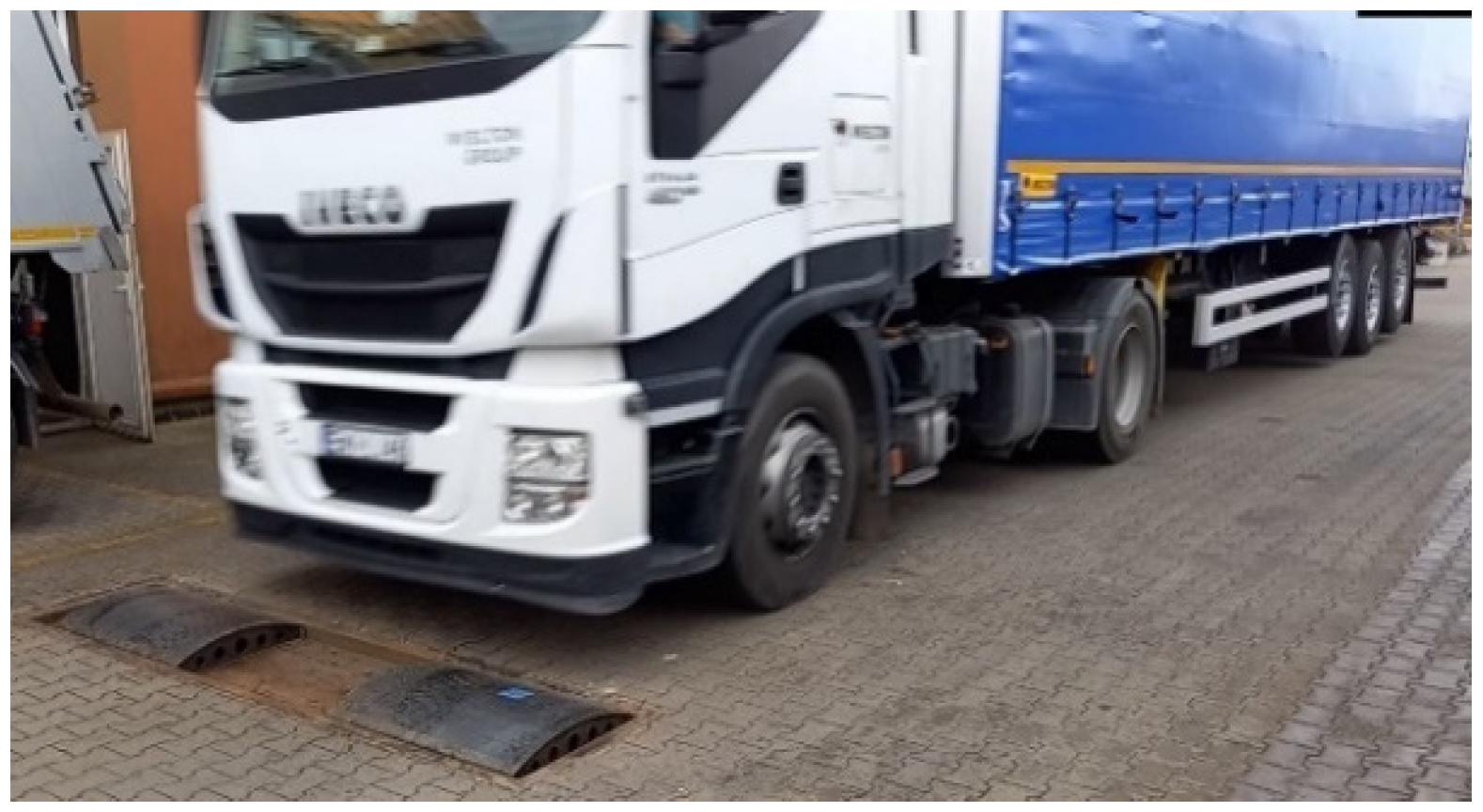

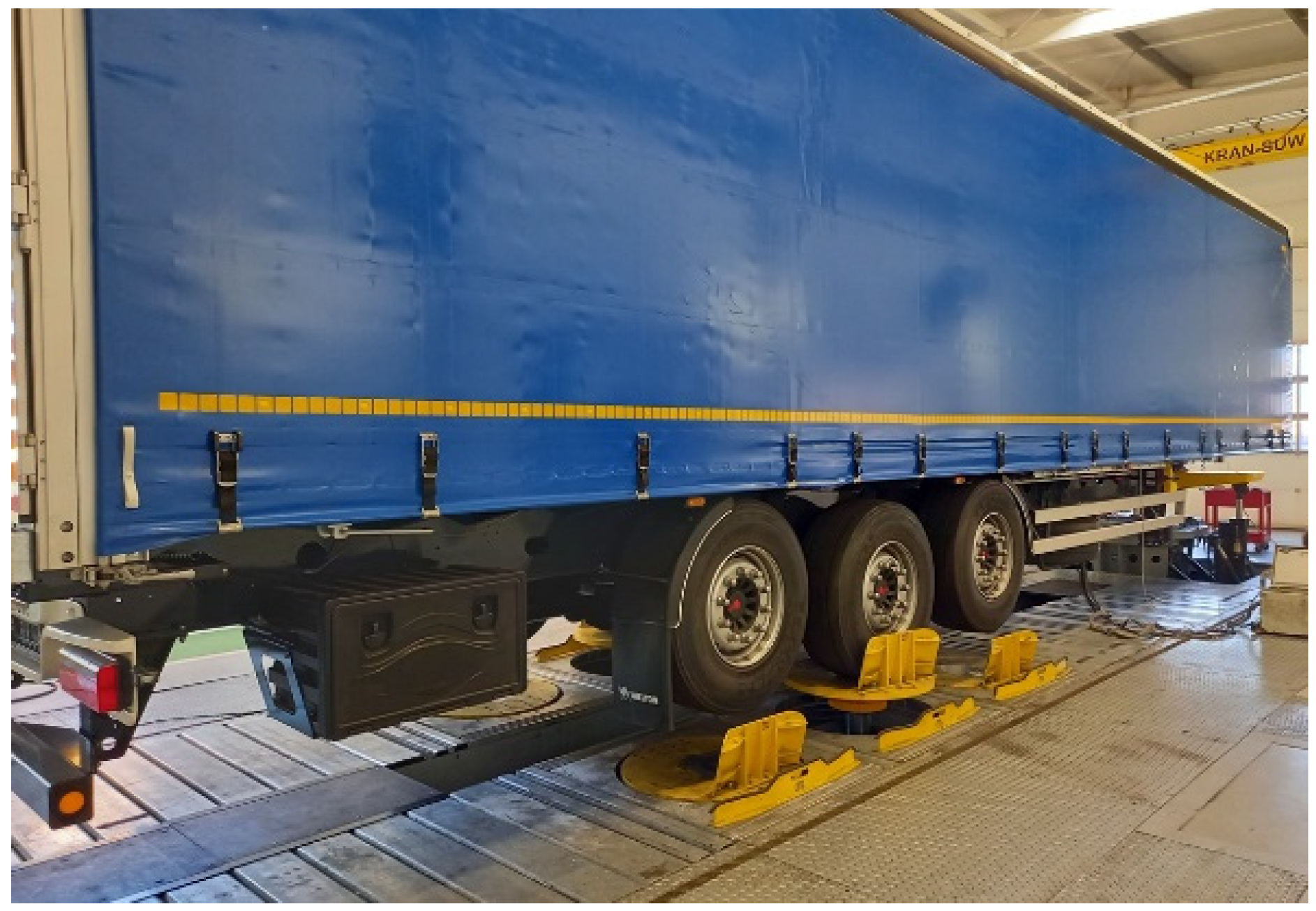

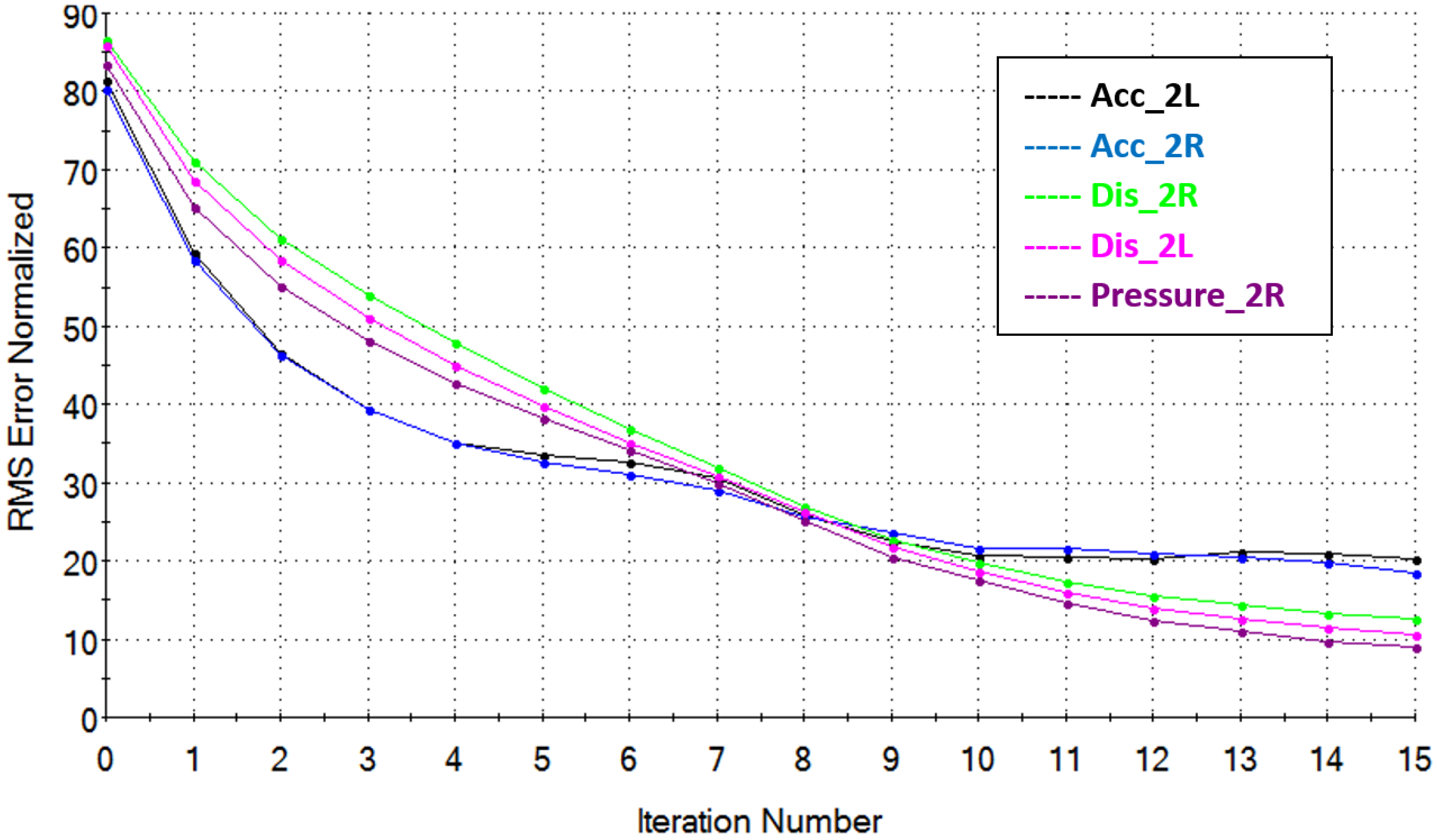
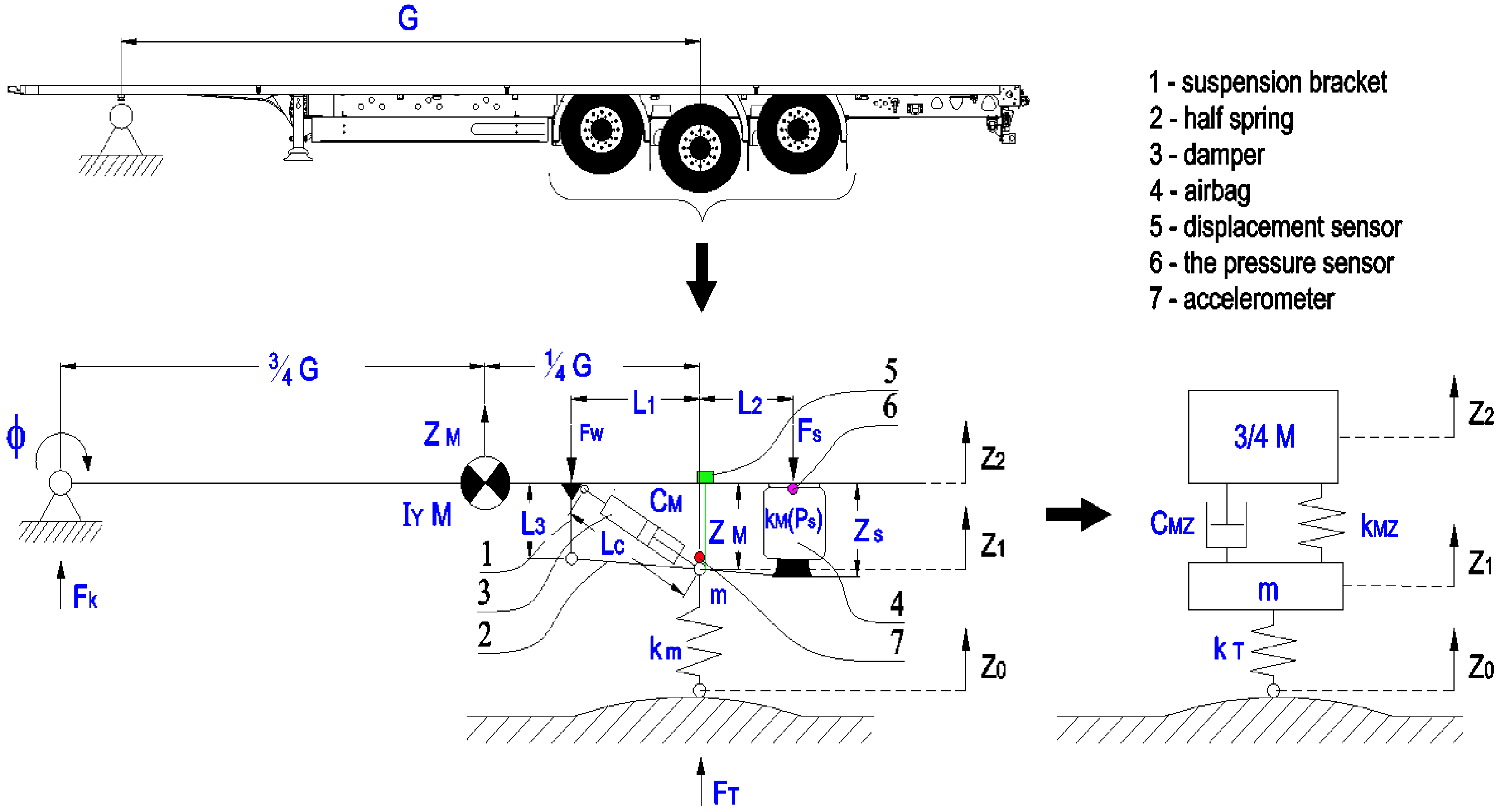

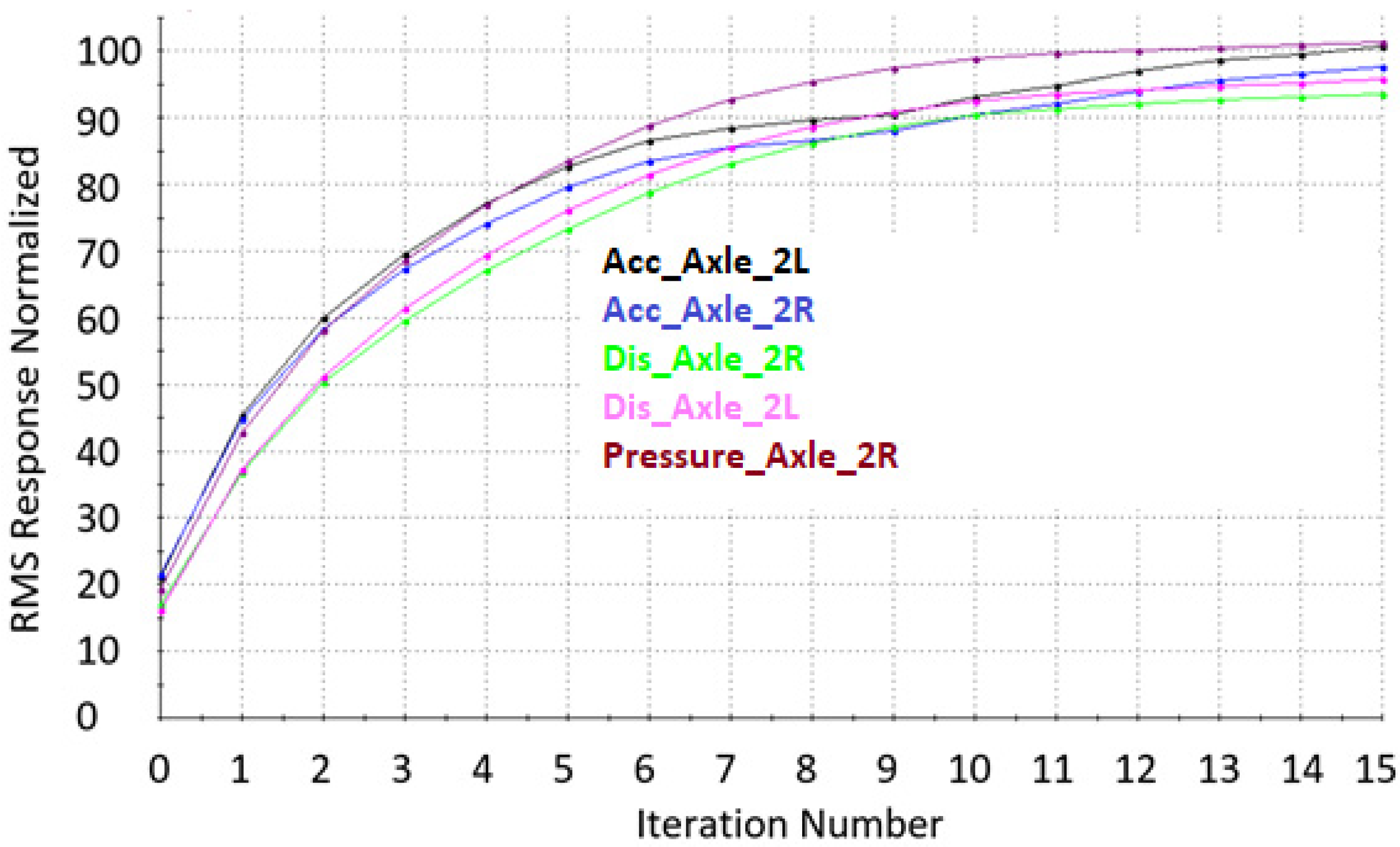
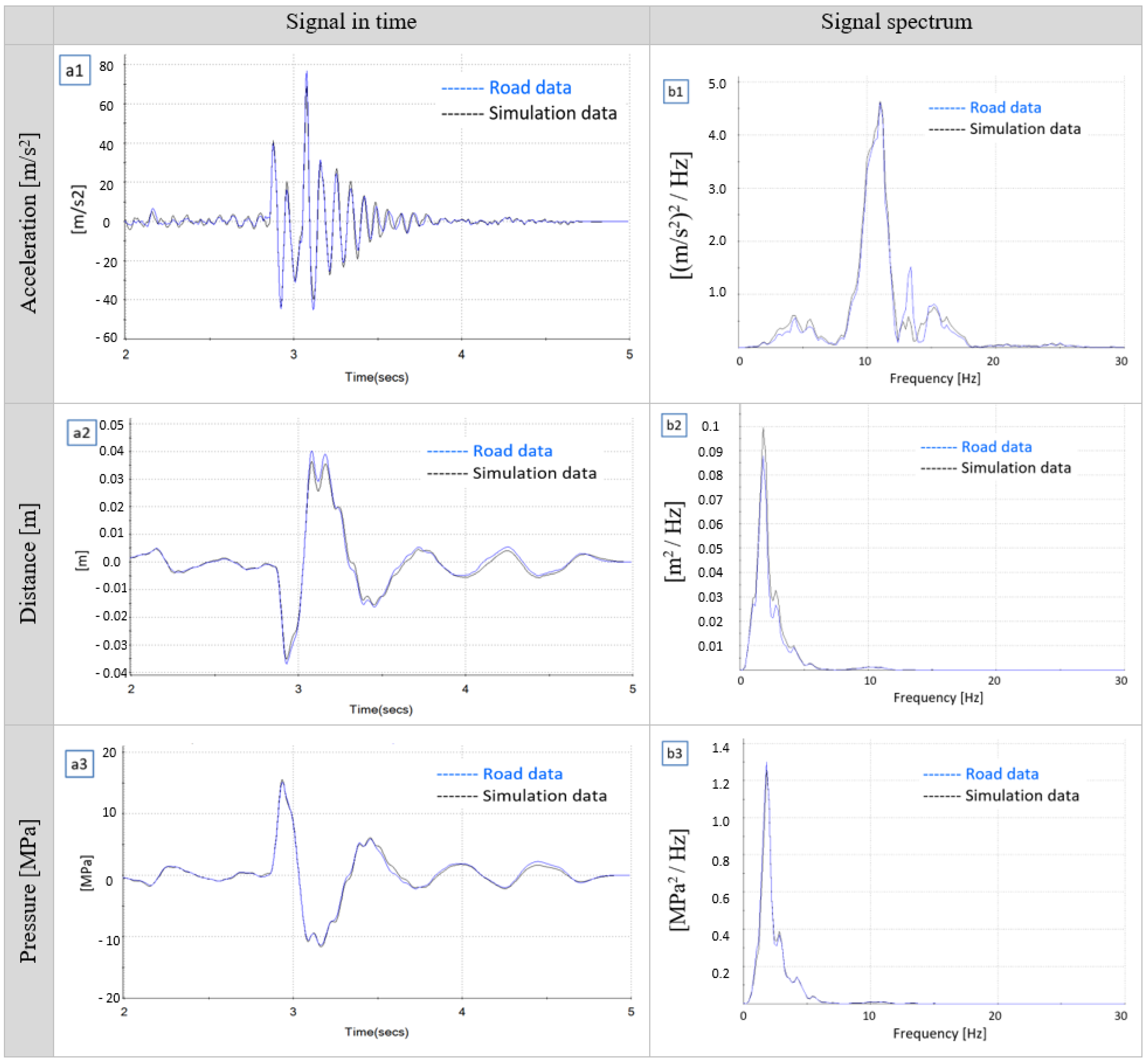
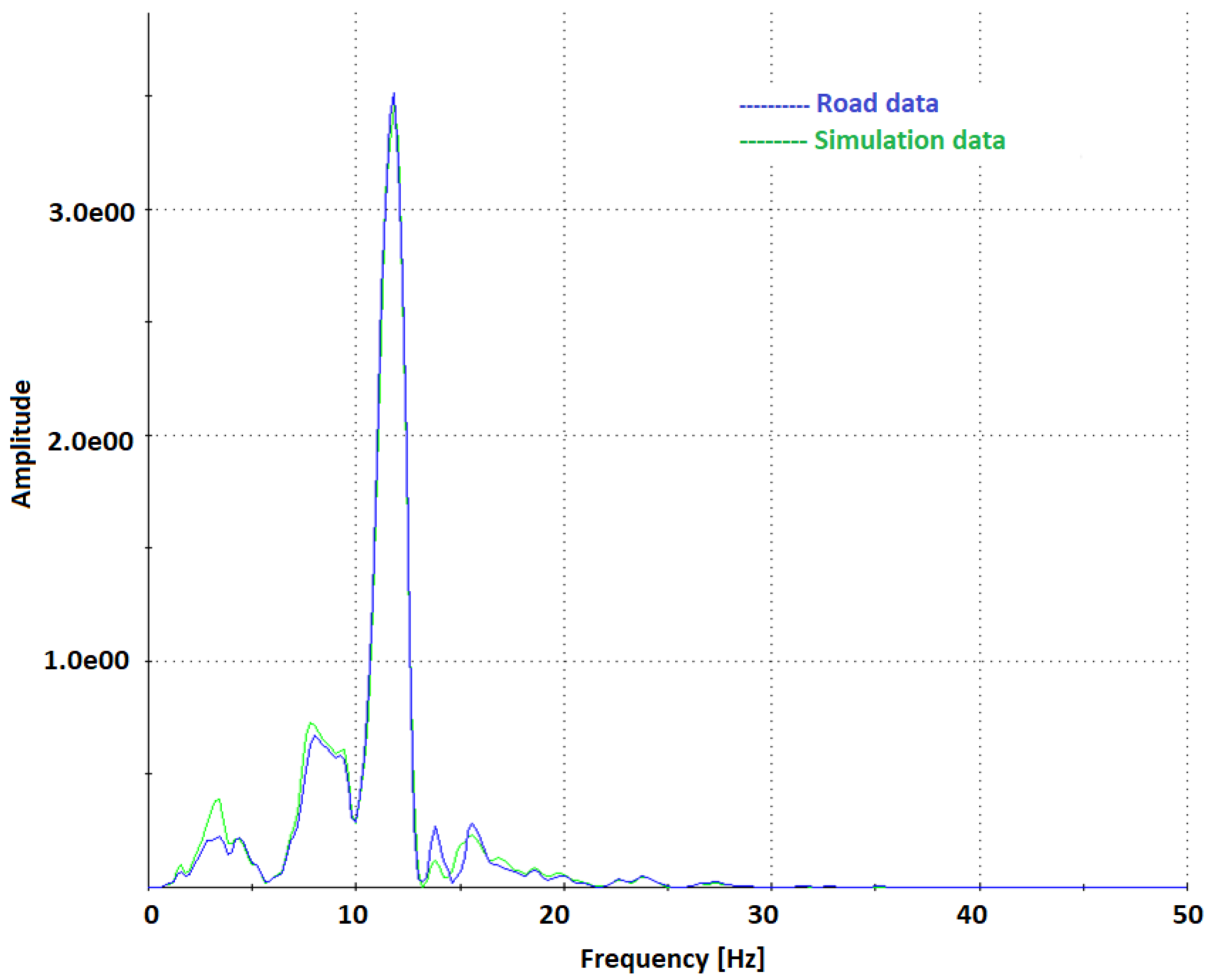

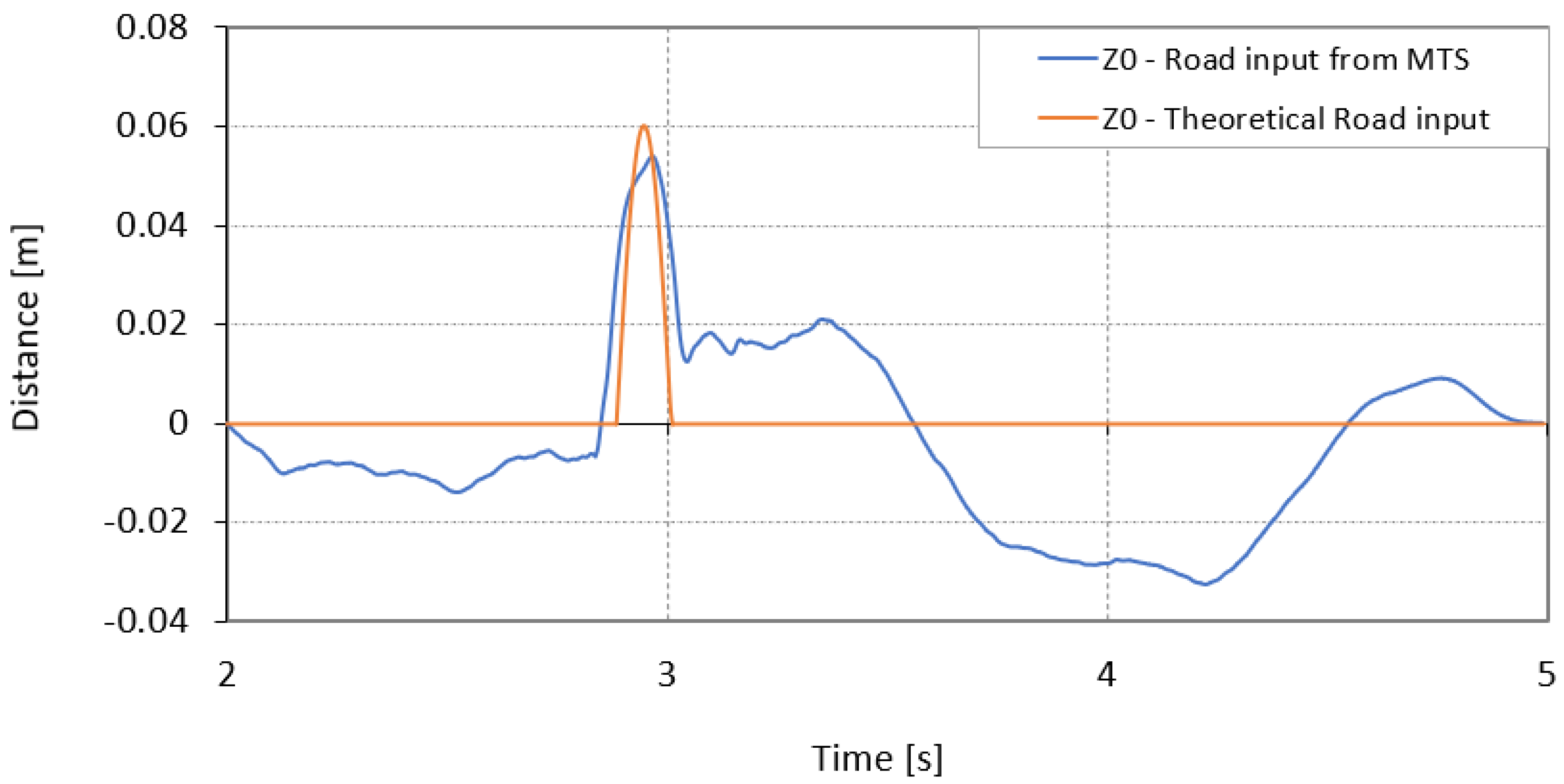
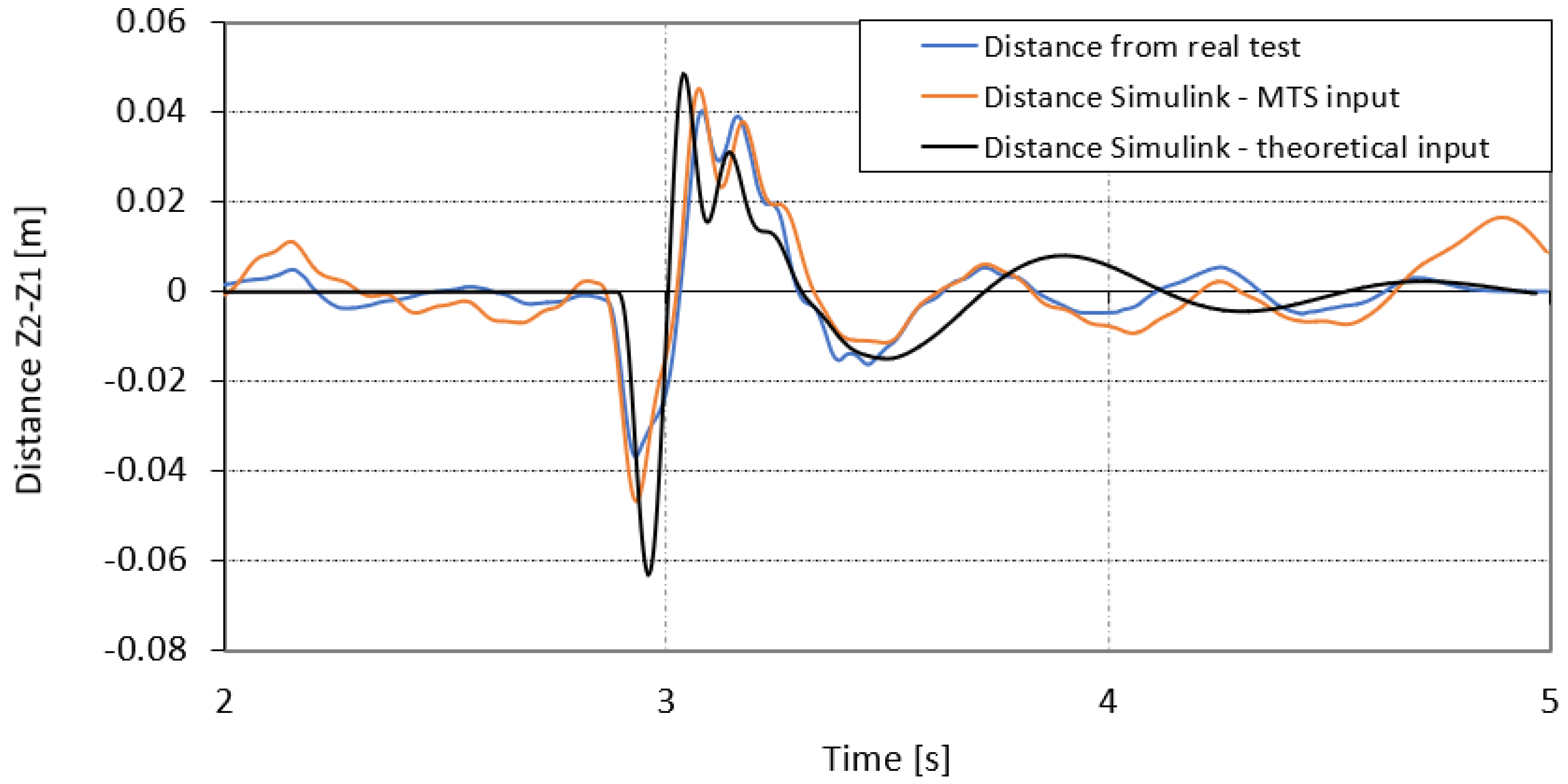
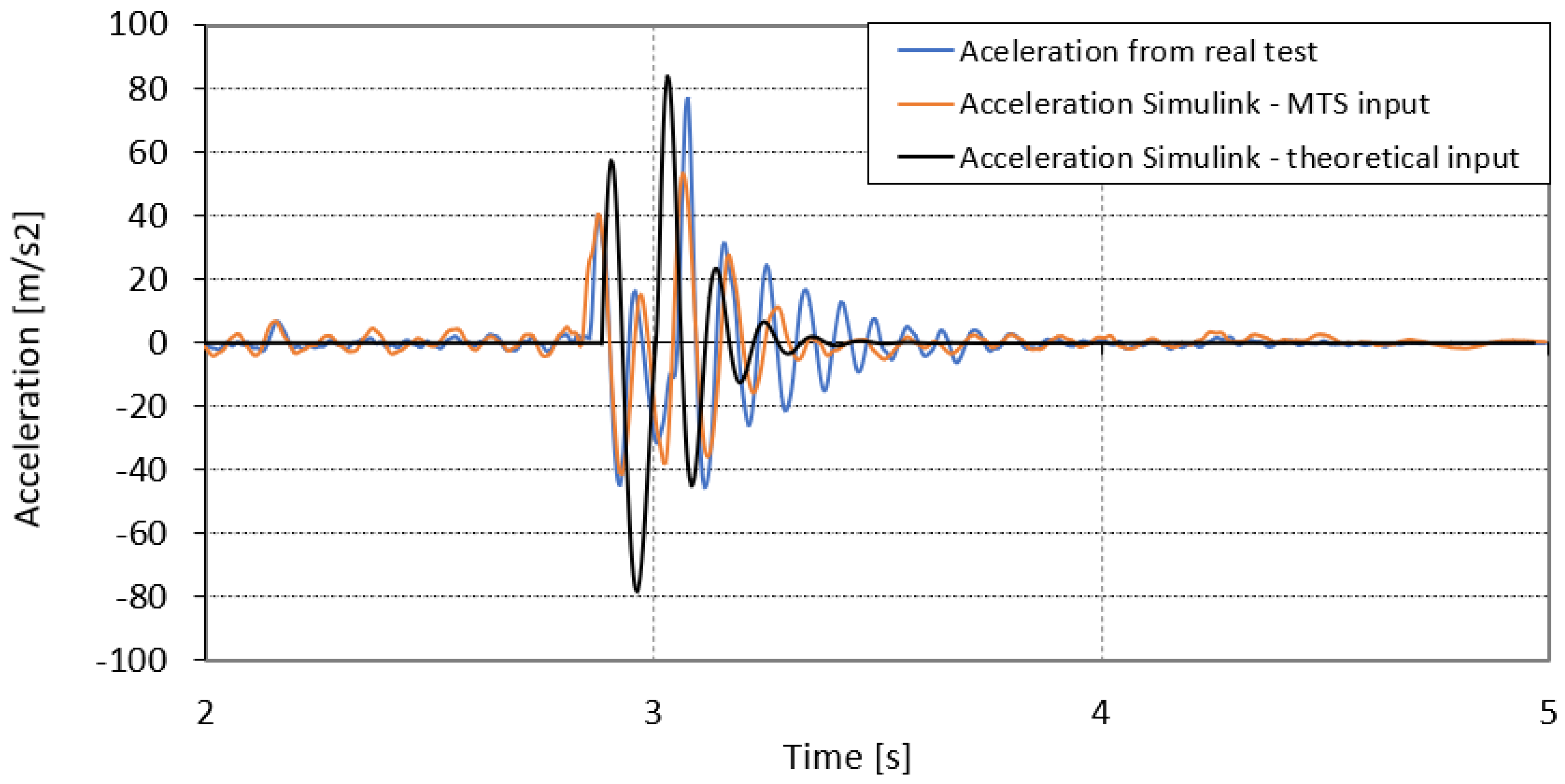
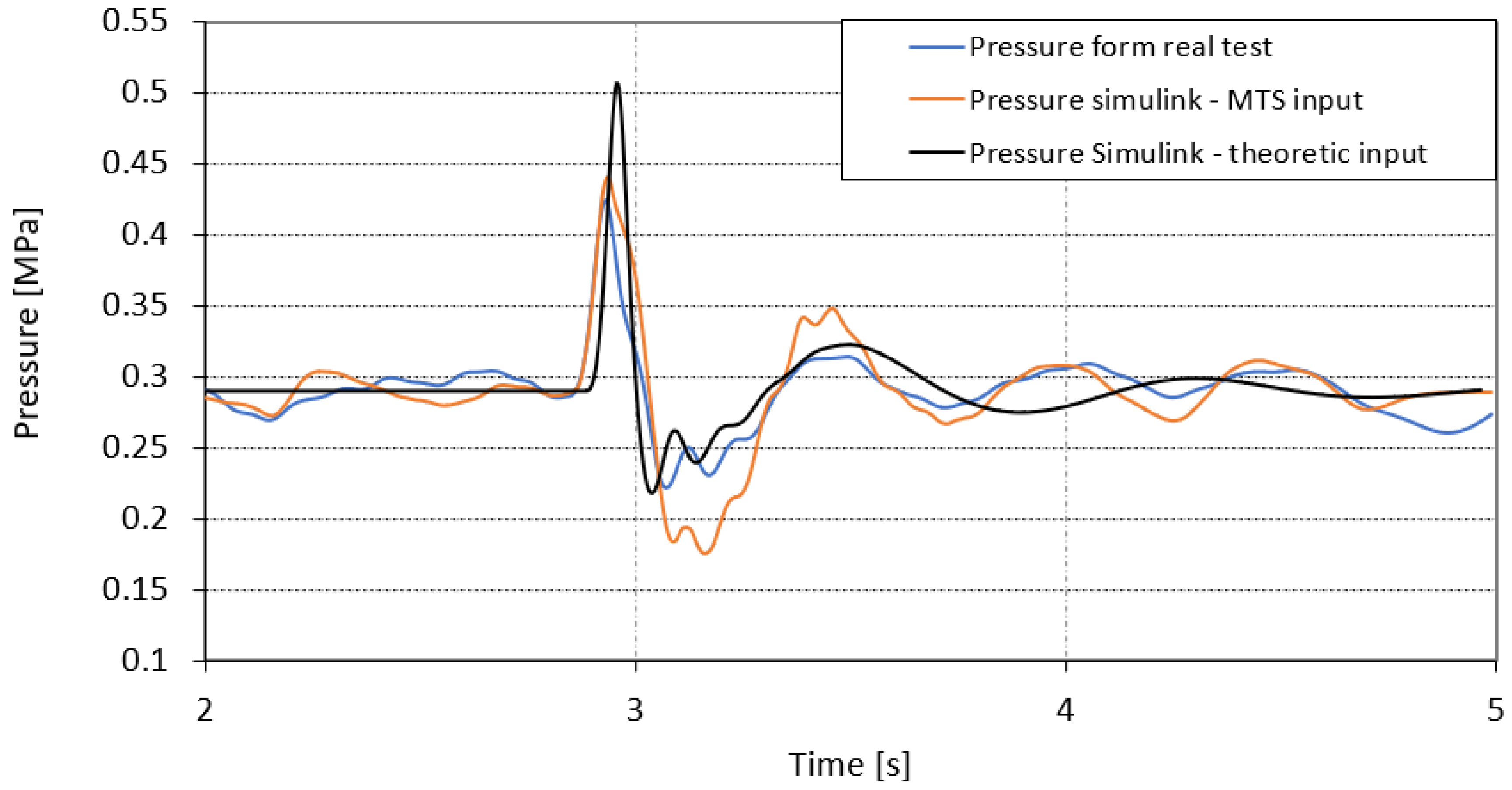
| Description | Symbol | Value | Units |
|---|---|---|---|
| Sprung mass | M | 5600 | [kg] |
| Non-sprung mass | m | 700 | [kg] |
| Suspension stiffness coefficient for the set pressure in the air spring | kMZ | 84,500 | [N·s/m] |
| Shock absorber’s damping coefficient—rebound | CM (R) | 46,000 | [N·s/m] |
| Shock absorber’s damping coefficient—compression | CM (C) | 14,000 | [N·s/m] |
| Tires stiffness coefficient | kT | 1,125,000 | [N·s/m] |
| Pin-axle distance | G | 7.70 | [m] |
| Set ride height | ZM | 0.25 | [m] |
| Semi-spring’s length, bracket-axle | L1 | 0.5 | [m] |
| Semi-spring’s length, axle-air spring | L2 | 0.35 | [m] |
| Height of the suspension bracket | L3 | 0.25 | [m] |
| Initial length of the shock absorber | LC | 0.49 | [m] |
| Tires | 385/65/R 22.5 | 5600 | [kg] |
| Signal Type | MTS 320 Road Simulator | Simulink Input Signal from the MTS | Simulink—Obstacle’s Theoretical Signal as the Input Signal |
|---|---|---|---|
| RMS error for Acceleration | 1% | 11% | 24% |
| RMS error for Displacement | 6% | 8% | 11% |
| RMS error for pressure | 3% | 9% | 12% |
Disclaimer/Publisher’s Note: The statements, opinions and data contained in all publications are solely those of the individual author(s) and contributor(s) and not of MDPI and/or the editor(s). MDPI and/or the editor(s) disclaim responsibility for any injury to people or property resulting from any ideas, methods, instructions or products referred to in the content. |
© 2023 by the authors. Licensee MDPI, Basel, Switzerland. This article is an open access article distributed under the terms and conditions of the Creative Commons Attribution (CC BY) license (https://creativecommons.org/licenses/by/4.0/).
Share and Cite
Czarnuch, A.; Stembalski, M.; Szydłowski, T.; Batory, D. Analysis of the Correctness of Mapping the Passage of a Semi-Trailer through a Road Obstacle on a Road Simulator. Sensors 2023, 23, 8225. https://doi.org/10.3390/s23198225
Czarnuch A, Stembalski M, Szydłowski T, Batory D. Analysis of the Correctness of Mapping the Passage of a Semi-Trailer through a Road Obstacle on a Road Simulator. Sensors. 2023; 23(19):8225. https://doi.org/10.3390/s23198225
Chicago/Turabian StyleCzarnuch, Arkadiusz, Marek Stembalski, Tomasz Szydłowski, and Damian Batory. 2023. "Analysis of the Correctness of Mapping the Passage of a Semi-Trailer through a Road Obstacle on a Road Simulator" Sensors 23, no. 19: 8225. https://doi.org/10.3390/s23198225
APA StyleCzarnuch, A., Stembalski, M., Szydłowski, T., & Batory, D. (2023). Analysis of the Correctness of Mapping the Passage of a Semi-Trailer through a Road Obstacle on a Road Simulator. Sensors, 23(19), 8225. https://doi.org/10.3390/s23198225








